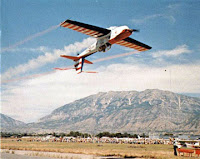A JANUARY PHOTO SHOOT
It all started with a phone call the night before telling me
to be at the airport for an 11:00 briefing for a long awaited photo shoot. The subject was a
recently re-restored 1938 Beechcraft SD17S Staggerwing owned by a retired
businessman from West Vancouver. We wanted to get some air to air shots for a
magazine article and this was the first day that both the weather and
everyone’s schedules coincided. The plan called for using a Robertson
helicopter, a 4 place R44 as the camera ship as we could take the doors off for
unrestricted sightlines. It seemed like a good plan, everyone inside and warm except
the photographer – me.
 |
| Photo ship pilot & owner, Roy Heaps |
The air temperature on the ground was -4C[i] with calm winds, sky clear
and a million. How can it get any better? I had a borrowed arctic type flight
suit and an all Canadian Toque. Gloves were a problem though, if they were to
be warm, they’d be too thick to operate the cameras. Oh well, tough it out bare
handed and get on with it.
Everyone involved got together and arrangements were briefed for altitude, direction of flight for the best light and the backgrounds, airspeeds and radio frequencies were confirmed. As the R44 cruises at 110, it was agreed by all that the Staggerwing, being faster, would form up on the helicopter as required.
The air was smooth with no wind to speak of. The local
mountain peaks were clear with a coating of fresh snow made which made for an
excellent backdrop for the bright yellow Staggerwing.
 |
| Staggerwing over north shore mountains |
During the shoot, the helicopter pilot would yaw the
helicopter towards the Staggerwing to help position the shots and this of
course put even more cold air into the back cabin. At one point I became
concerned when it appeared that I had a camera failure. I switched to a backup camera
only to have the same issue. As it happened, both cameras were fine; it was my
hands that weren’t. I was losing feeling in my fingers and couldn’t feel the
camera controls. The pain from the cold
quickly became unbearable. (See foot note.) However, as we changed locations or
the Staggerwing repositioned, I took the opportunity to get the gloves back on
and restore some semblance of feeling to my hands.
All went well and as a result, we got the last of the pictures
we needed.
[i]
A quick check with “Professor” Google, a temperature of -4C and an airspeed of
110 mph = a wind-chill of -43C!








